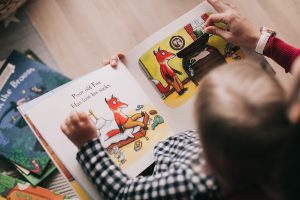How can Teacher Librarians Support Literacy?
 In today’s times of rapidly changing technologies, innovative learning environments, online communities, digital citizenship, and increasing amounts of information, it is essential to be reminded that the core aim of a school library is ‘literacy.’
In today’s times of rapidly changing technologies, innovative learning environments, online communities, digital citizenship, and increasing amounts of information, it is essential to be reminded that the core aim of a school library is ‘literacy.’
Good readers are made when children read a lot, and I honestly believe that the school library plays a crucial role in boosting the same.
However, merely having a room that is dedicated to the usual library resources is not enough; it must be adequately staffed by skilled librarians who can implement effective school library programs.
It is through the reading program that information and digital literacy skills can be mastered. There are numerous events and activities of varying scales and impact that you can use to promote reading literacy and the library’s contribution to it. Special displays, events, policies, practices, and attitudes of the library can help to support student literacy.
As a PYP Teacher Librarian at JBCN, we call our library ‘Learners Resource Centre’, simply to help imbibe in the mind of our learners that the school library is their first resource centre. From there, they will be guided to appropriate and authentic resources.
I’m sharing some of the specific strategies that I use to ‘Implement Literacy in my learners through the L.R.C (as we fondly call it)’ and hopefully it will help others to gain the results that I have achieved using the same. The strategies shared below can be applied to the PYP and MYP as well. These strategies are all ‘doable’ and do not require any specific investment of budget or time. Most of the activities involve one of the key factors in effective library programming, which is teacher-collaboration.
Library Program:
Being a Resource Facilitator: One of the critical roles of school librarians is to help  teachers and their learners find resources. Assisting teachers to identify relevant and appropriate books and articles for their planning to have greater value. Part of this help may even include letting the teachers know the reading levels of the available books.
teachers and their learners find resources. Assisting teachers to identify relevant and appropriate books and articles for their planning to have greater value. Part of this help may even include letting the teachers know the reading levels of the available books.
Updates regarding new books or any new additions to the library resources must be provided to the entire staff and learners regularly.
Providing a literate environment through a wide variety of book selection: I ensure that our LRC provides age and skill-appropriate materials for all kinds of readers from the struggling to the ardent ones. I study the reading and literacy level of my learner through observation, discussion, activities, and teacher feedback and then provide them with age-appropriate materials they can manage, including topics and genres of the child’s interest. I make sure to select a variety of books in different subjects, genres, or topics to add to my collection. When learners have access to interesting books and materials, they are more likely to read for extended periods, leading to increased literacy levels.
Support for students with special needs: There must be a specific resource provision for learners with special needs. The Teacher-Librarian must be able to recognise the individual need of her learners and support them working in collaboration with the Homeroom Teacher or the Special Education teacher.
Promote uninterrupted & secure access to books: I ensure that my teachers and learners always have easy and flexible access to books and resource materials. Research shows that there is a decline in reading if a librarian starts implying any kind of barriers to learners with regards to using the library space and resources. It should always be accessible. Our LRC also provides detailed labeling and segregation of shelves helping the learners to identify their level of reading and providing easy access.
I have divided the LRC cabinets according to the reading levels of the learners and keep reiterating the same to them, teaching them the differences, helping them identify different ways to select a book for themselves.
Support Classroom Libraries: As a teacher-librarian, I provide UOI, theme, or learner profile attribute-based books to the classes regularly, as my learners only visit the library once per week and hence get limited time to read for pleasure. Having interesting books stocked in their class gives them the provision to read at any available time throughout the week.
Buy student-recommended titles: I have placed an attractive box at the entrance of the LRC labeled as “I would like to read….” The learners are free to put in any reading recommendations. The box is opened every fortnight, and then the title is purchased after thoroughly reviewing the same. This process gives the learners ownership of the library.
Facilitate ‘silent reading’ time: Though opportunities for silent reading at school may be limited, for some struggling readers, it is the only book reading opportunity they get. Therefore I ensure I give them at least one class a month dedicated to silent reading.
Encouraging Reading: Many teachers are concerned about whether their students are going to love reading. Still, they rarely have time to work this into their curriculum; here is where the Teacher Librarian plays a particularly important role. They can build reading habits by creating a positive environment in the library and through extra-curricular reading programs can be a significant contribution.
Introducing and teaching different genres of reading through reading Aloud. Most of my classes revolve around read-aloud sessions, where I am reading the story to my learners. Reading aloud offers benefits beyond mere enjoyment.
Dramatisation of favourite stories, puppet shows.
Barter-a-Book & Book Talks: Another exciting way to promote and increase literacy is by encouraging students to tell stories, share what they have read and exchange books. Oral storytelling provides a bridge to written stories. I dedicate one class in a month to a narration of stories by learners and/or book talks. This gives a platform to learners to discuss, understand various aspects of writing such as plot, characters, theme etc.
The Review Crew: I have created a shelf where new books are displayed regularly, and the learners can pick up any book of their choice, read and then present the book review to the class. On the accomplishment of their review presentation, they receive a ‘Review Crew’ badge and certificate. This activity gives children immense confidence and increases their motivation and commitment to reading more books.
Author Visits: Getting learners pumped on a specific book or series by inviting authors to visit the school library is one of the most common features of my LRC program. The authors who not only share their books with the children but also provide insights into the creative processes involved in writing.
Literary Week is a significant event at our school as we celebrate literacy in the form of reading and writing activities and games, e.g. Scavenger Hunt & Inter House Reading Quiz and online literary quizzes and games.
Author birthday celebrations and/or genre themed events are one of the regular features of our LRC, which is extensively planned and organised by the learners. This allows them to be independent and decision-makers.
Character Dress-Up Parade: This is an elaborate yearly event where a learner just doesn’t dress up like his/her favourite character they even get a chance to recite their few dialogues in front of an audience.
- Birthday Book Clubs
- Creating Book Mobiles and charts of their favourite books.
- A view into various styles of Illustrations and conducting activities based on it.
- Story-writing, creating a newspaper. After teaching the relevant vital aspects of story and article writing the learners are asked to create their own imaginary story or newspaper article. Selected stories are then published into a book exclusively for our school.
- Educating our learners with various Library Skills ranging from different parts of a book and their functions, shelving, call labels, alphabetical orders, Dewey Decimal System etc. is an on-going process which takes place in most of my classes.
- Reading Diary – I have created a Reading Diary Reflection with prompts that provide an opportunity for learners to express their responses to the texts, thoughts, feelings and other noticings.
- “What’s Your Book Quotient?” We actively participate in inter-school reading competitions, inculcating the habit of reading and healthy competition in children. We conduct an Interbranch reading quiz for our learners called “What’s Your Boko Quotient?” which is similar to “Battle of the Book”. Lots of kids love competition, so why not make reading a healthy competitive sport?
- Create a summer reading program: I carefully go through and prepare a regular grade-wise Summer Recommended Reading list and summer reading activity/assignment for my learners for their summer break.
Collaboration with Teachers and Curriculum planners
Planning between the teachers and the librarian goes hand in hand. I am a part of all curriculum meetings and as the ALA quotes “co-design, co-implement, and co-evaluate interdisciplinary lessons and units of instruction that result in increased student learning. Participate by collaboratively teaching reading comprehension strategies: assess and use background knowledge, pose and answer questions that are appropriate to the task, make predictions and inferences, determine main ideas, and monitor reading comprehension, as well as the learning process”.
The LRC provides theme-related books and different forms of Reading Programs like Jolly Phonics, Oxford Reading Tree, A to Z reading, Handwriting without Tears to support curriculum topics through all grades.
E-books: E-books give students a full reading experience by emerging them into the text using animations, sound effects, and relevant imagery. Tools like animation help students to infer and learn the definition of unfamiliar vocabulary in a fun and engaging way. I encourage e-book reading time in class and also organise an Inter-House e-book reading quiz called the “Reading Quizzaders.”
Research: Librarians role is supporting teachers and students to learn to use different resources for their research. Familiarising children with the research section of the library, understanding how to look for information in a reference book, sifting fact from opinion, and other such related skills are taught through a planned program—knowing how to use dictionaries, encyclopaedias, almanacs, and yearbooks. I ensure that ‘searching strategies’ using Google is valuable and is included in my program. Implementation of research skills such as evaluating resources, developing citation skills, report writing skills is taught through activities and lessons.
The challenge will always remain, to find authentic collaboration by realigning goals as a teacher-librarian with that of the school curriculum, of course placing ‘literacy’ at the top of all. Dynamic school libraries are a key component of quality education, one that benefits both – learners and teachers.
Good work is focusing on the right areas of the school community to combat the literacy crisis.
On a final note, let’s not forget, learning to search for the right information and determining its value is a 21st-century skill, one who holds an imperative position in professions and lifestyles.
– By Rozmeen Saifee – PYP Teacher Librarian @ JBCN International School, Parel, Mumbai.


I am very thankful to you.you gave us good information about the TEACHER LIBRARIANS SUPPORTING LITERACY(Librarian role,Library Activity,Literacy News) pls give me some ideas for planning.
Thanks
Thank you for your appreciation will surely try and write on planning and share more experiences 🙏